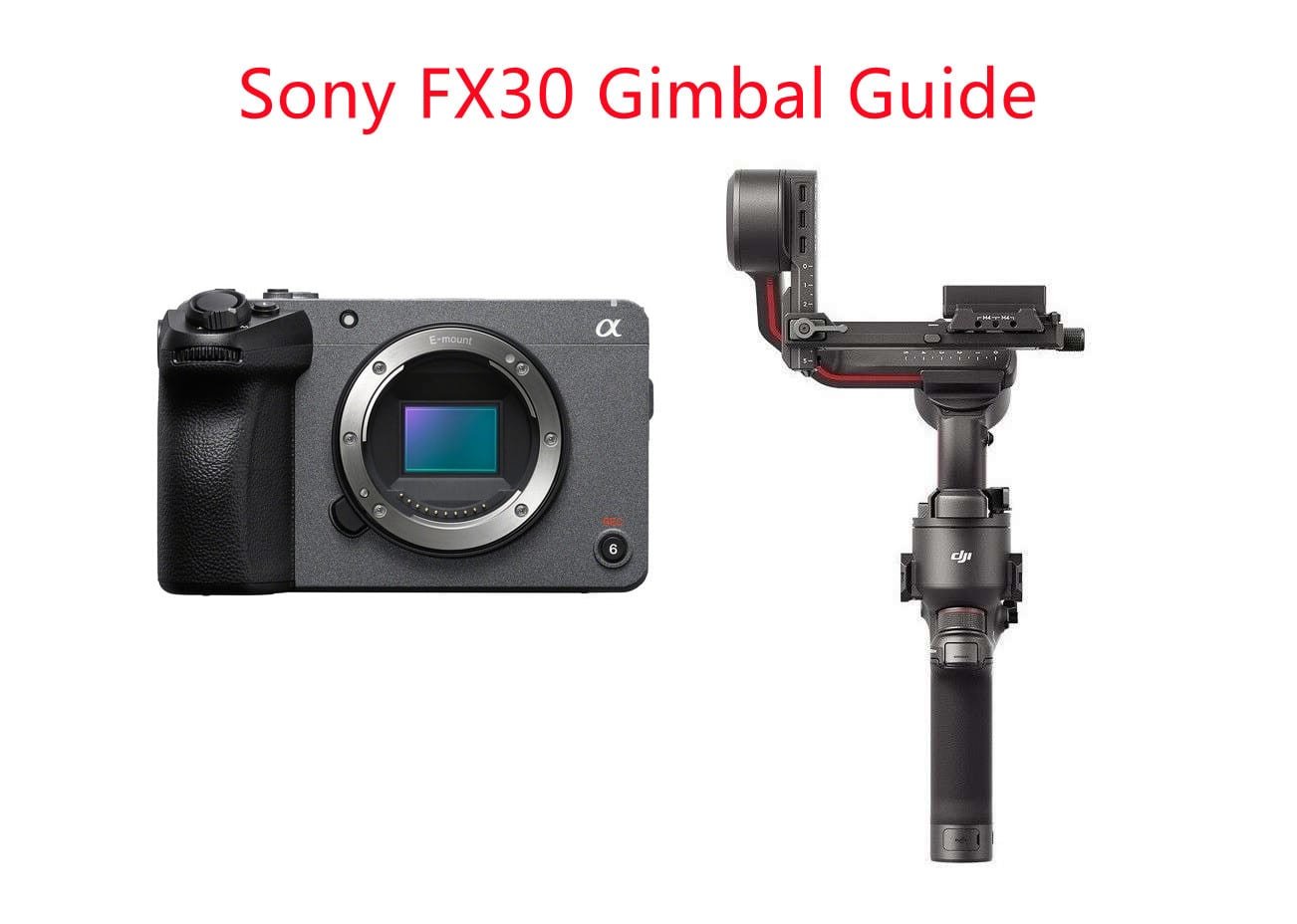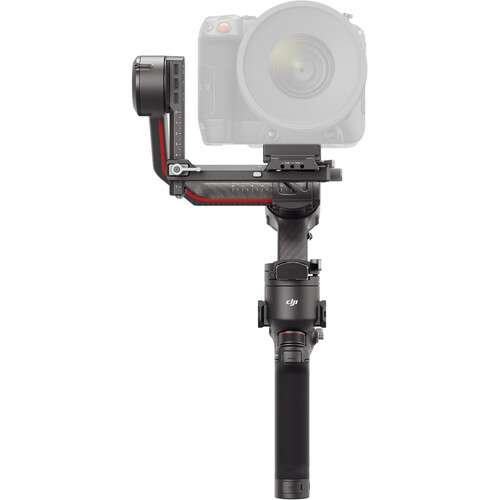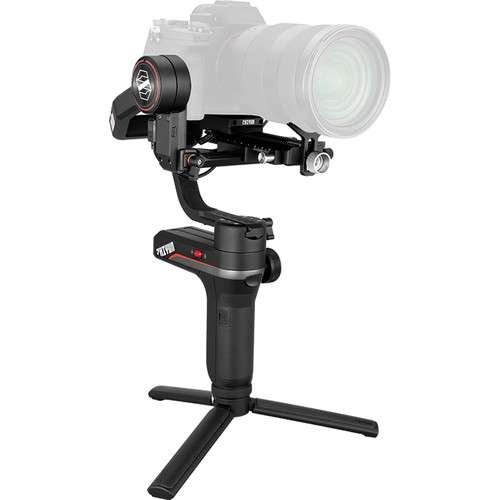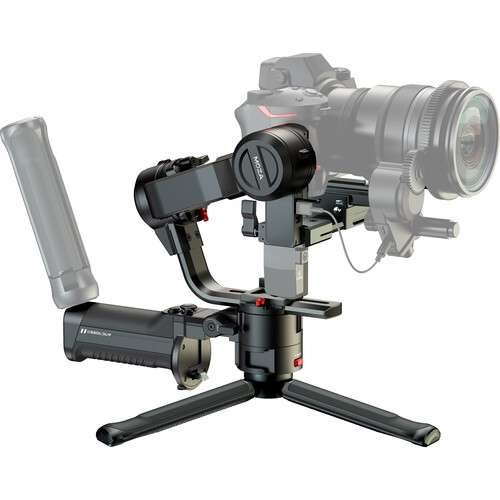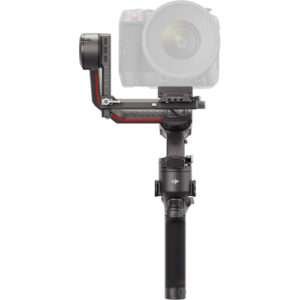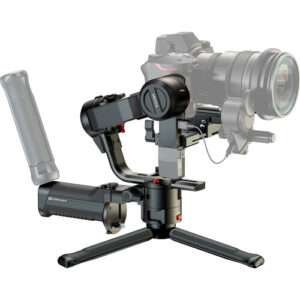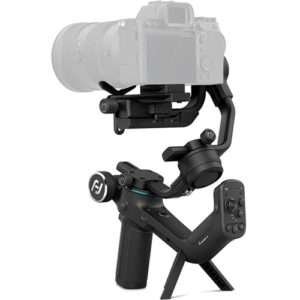Best Gimbals for Sony FX30
The Sony FX30 is a powerful APS-C cinema camera that has gained a reputation as one of the most versatile and advanced cinema cameras on the market. As a result, it is a popular choice among professional filmmakers, content creators, and videographers who demand high-quality footage and smooth camera movements. However, to achieve truly cinematic results with the Sony FX30, a good gimbal is essential.
A gimbal is a tool that helps stabilize the camera, allowing for smooth and stable footage while moving. It is particularly useful for capturing dynamic shots, such as walking or running sequences, panning or tilting movements, or even aerial shots. The right gimbal can make all the difference when it comes to achieving professional-quality footage, which is why it’s important to choose the best gimbal for your Sony FX30 camera.
There are many different gimbals on the market, each with its own features and benefits. Some are designed specifically for the Sony FX30, while others are more universal and can be used with a variety of different cameras. In this guide, we have curated a list of the finest gimbals presently available for the Sony FX30 cinema camera. To present you with a comprehensive range of options, we have taken various aspects into account, including maximum payload capacity, battery runtime, charging time, weight, connection types, display screens, and smartphone app compatibility.
Our selection encompasses an array of gimbals, ranging from entry-level models ideal for beginners to high-end gimbals featuring advanced features and professional-level performance, catering to all types of users. Whether you’re a seasoned videographer seeking the best of the best or a beginner looking to capture smoother footage, our guide offers you the requisite information to make an informed decision. So let’s delve in and explore the top gimbals available for the Sony FX30 cinema camera.
And if you’re interested in other accessories for your Sony FX30, be sure to check out our Sony FX30 Memory Card Guide and Sony FX30 Lens Guide for even more helpful recommendations.
Sony FX30 Store Links: B&H, Adorama.
Best Gimbals for Sony FX30
Based on our extensive research and personal experience, we have curated a list of the best gimbals that are fully compatible with the Sony FX30 cinema camera. We have handpicked these gimbals based on their exceptional stability, versatility, and performance, enabling photographers and videographers to effortlessly capture stunning, professional-grade footage.
To provide you with a comprehensive analysis of each recommended gimbal, we have crafted detailed reviews that delve into their key features, advantages, and disadvantages. Whether you are an experienced filmmaker or a novice, our selection of gimbals offers a range of options to suit varying needs and budgets. With our help, you can be confident that you’ll find the ideal gimbal to complement your Sony FX30 and achieve the desired results.
Image | Product | Features | Price |
| |||
| |||
| |||
| |||
| |||
|
1. DJI RS 3
Best Overall Gimbal
DJI RS 3 Key Features:
- Max. Payload: 6.6 lb / 3 kg
- Battery Runtime: 12 Hours (Removable, 3000 mAh)
- Battery Charging Time: 2.5 Hours (Supports 18W PD Fast-charging)
- Connections: Bluetooth 5.0, USB-C
- Display: 1.8-inch OLED Touchscreen
- Smartphone App: Yes
- Compatiblitle Cameras: Click Here to Check
- Weight: 2.2 lb / 990 g
- Dimensions: 410 x 260 x 195 mm
- Warranty: 1 year
- Special Feature: 3rd-Gen RS Stabilization Algorithm, Instant Mode Switching, Supports Wireless Image Transmitter, Motion Control with Smartphone, PD Fast Charging, Multiple Operation Modes, Fine-Tuning Knob on Tilt Axis, Wireless Shutter Control, Lots of accessories
- Store links: B&H, Adorama.
Pros
- 1.8-inch OLED Color touchscreen
- Up to 3 kg payload
- Beyond Smooth
- Instant Mode Switching
- Customizable Front Dial
- Bluetooth shutter button
- Stabilizes full-frame systems
- Wireless and integrated controls
- Quick-Release Design
- 12-Hour Operating Time + Fast Charging
Cons
- Long lenses may not fit
The DJI RS 3 Gimbal is a versatile and lightweight tool that is perfect for filmmakers who are looking for a stable and reliable way to capture smooth and steady footage. With a maximum payload of 3 kg, this gimbal is well-suited for filmmakers who want to stay light and mobile while shooting, such as elopement wedding filmmakers or travel vloggers.
One of the main advantages of the DJI RS 3 is its advanced stabilization system, which is based on the 3rd-Gen RS Stabilization Algorithm. This technology provides a smooth and stable platform that makes it easy to capture cinematic footage. Additionally, the gimbal features a Fine-Tuning Knob on Tilt Axis that allows for precise adjustments to be made in order to get the perfect shot.
The DJI RS 3 comes with a variety of features that make it one of the best gimbals on the market. The Instant Mode Switching feature is particularly useful, allowing the user to switch between different modes with ease. The gimbal also supports Wireless Image Transmitter, which enables the user to wirelessly transmit footage to a remote monitor or smartphone app. Furthermore, the Motion Control feature allows the user to control the gimbal with a smartphone, making it even more versatile and user-friendly.
The gimbal also features an advanced 1.8-inch OLED Touchscreen that displays all relevant information, making it easy to use and navigate. This display is customizable and allows the user to adjust settings such as motor strength, speed, and response, and it also supports Wireless Shutter Control, which lets the user start and stop recording remotely.
One of the main benefits of the DJI RS 3 is its long battery life, which provides up to 12 hours of operating time on a single charge. The battery is removable and supports fast charging, which enables the user to quickly recharge the gimbal and keep it ready for use.
Finally, the DJI RS 3 is lightweight and compact, weighing only 2.2 lb (990 g) and measuring 410 x 260 x 195 mm. This makes it easy to carry around and use in a variety of situations, and the Quick-Release Design makes it simple to attach and detach the camera from the gimbal.
In summary, the DJI RS 3 Gimbal is an excellent choice for filmmakers who want a reliable, versatile, and user-friendly gimbal that provides advanced stabilization and a range of useful features. Whether you are a travel vlogger, elopement wedding filmmaker, or any other type of filmmaker, the DJI RS 3 is a great investment that will help you capture smooth and professional-looking footage.
DJI RS 3 Gimbal Stabilizer at B&H, Adorama.
DJI RS 3 Gimbal Stabilizer Combo at B&H, Adorama.
2. DJI RS 3 Mini
A Lightweight Gimbal
DJI RS 3 Mini Key Features:
- Max. Payload: 2 kg (4.4 ls)
- Battery Runtime: 10 Hours
- Battery Charging Time: 2.5 Hours
- Battery Capacity: 2450 mAh / 17.64 Wh
- Display: 1.4″ Full Color Touchscreen
- Smartphone App: Yes
- Compatiblitle Cameras: Click Here to Check
- Folded size: 323 x 195 x 98 mm
- Weight: 1.9 lb / 850 g (with Camera Plate)
- Warranty: 1 year
- Special Feature: 3rd Gen RS Stabilization Algorithm, Wireless Camera Control via Bluetooth, Horizontal & Vertical Modes, Panorama, Timelapse & Tracking Functions, NATO Rail for Handles & Accessories, Includes Extended Grip/Tripod
- Store links: B&H, Adorama.
Pros
- 2kg payload allows for pro lenses
- Color touch display menu
- Easy setup for landscape and portrait video
- Powered stabilization
- Arca-Swiss mounting plate
- Bluetooth camera control link
Cons
- Swing-out LCDs blocked in portrait mode
- Accessory system not as robust as bigger RS 3
- Smartphone activation required
- Doesn’t include onboard video light
As a filmmaker who often works with lightweight camera and lens combinations, I had the chance to try out the DJI RS 3 Mini gimbal with my Sony FX30 cinema camera, and I must say that I was quite impressed with its performance. Despite being a smaller and lighter version of its larger siblings, the RS 3 Mini is still a very capable gimbal.
One of the standout features of the RS 3 Mini is its compact and lightweight design. Weighing in at less than 800g, it is incredibly easy to handle and maneuver. I was able to use it for extended periods of time without feeling fatigued or uncomfortable. Additionally, the gimbal has a maximum payload capacity of 2 kg / 4.4 lbs, which is more than enough for my Sony FX30 camera and a range of lenses.
Setting up the gimbal was very easy and straightforward, and the color touch display menu made it easy to customize and adjust the various settings to my liking. The RS 3 Mini also offers a range of shooting modes, including horizontal and vertical modes, panorama, timelapse, and tracking functions, which allowed me to achieve some truly stunning shots.
Another feature that I really appreciated was the wireless camera control via Bluetooth. This allowed me to control the camera’s shutter, focus, and other settings directly from the gimbal, which was incredibly convenient and allowed me to stay focused on my shot without having to constantly fiddle with the camera.
However, one minor issue I encountered was that the swing-out LCDs on my Sony FX30 camera were blocked in portrait mode, which made it difficult to frame my shot properly. Additionally, the accessory system for the RS 3 Mini is not as robust as that of its larger siblings, which limits the types of accessories that can be attached to the gimbal.
Overall, I would highly recommend the DJI RS 3 Mini gimbal for anyone looking for a lightweight and compact stabilizer. It is incredibly easy to use and delivers smooth and stable footage, even when shooting in challenging conditions. While it might not have all of the features of the larger RS 3 gimbal, it is still a great entry-level option for filmmakers who want to take their work to the next level.
DJI RS 3 Mini Gimbal Stabilizer at B&H, Adorama.
3. DJI RS 3 Pro
High Payload Capacity, Most High-end Gimbal
DJI RS 3 Pro Key Features:
- Max. Payload: 9.9 lb / 4.5 kg
- Battery Runtime: 12 Hours (Removable, 1950 mAh)
- Battery Charging Time: 1.5 Hours (24W Fast-charging (QC 2.0 or PD))
- Connections: Bluetooth 5.0, USB-C
- Display: 1.8-inch OLED Touchscreen
- Smartphone App: Yes
- Compatiblitle Cameras: Click Here to Check
- Weight: 2.5 lb / 1143 g
- Dimensions: 415 x 218 x 195 mm, 276 x 268 x 68 mm (Folded)
- Warranty: 1 year
- Special Feature: LiDAR Focusing System, All-New Focus Motor, Long-Range Wireless Transmission, Extended carbon fiber material, 3rd-Gen RS Stabilization Algorithm, Automated Axis Locks, Wireless Shutter Control, Instant Mode Switching, Monitoring via Smartphone, Lots of accesories
- Store links: B&H, Adorama.
Pros
- Supports up to 4.5kg (10 lbs)
- Active track Pro support and 1.8-inch OLED touch screen
- Long battery life and fast charging
- Huge potential through accessories
- Strongest Carbon Fiber construction
- LiDAR focusing technology compatibility
- High-Bright Remote Monitoring
- Intuitive and user-friendly control
Cons
- Priced for pros
- Some accessories are equally expensive
As a professional videographer, I recently had the chance to use the DJI RS 3 Pro gimbal stabilizer with my Sony FX30 cinema camera, and I have to say, it’s easily the most advanced gimbal stabilizer I’ve used so far. The device is firmly aimed at professionals who want to make Hollywood-style camera moves with heavy camera and lens payloads up to 4.5kg. The DJI RS 3 Pro has many new features, including a tilt balance fine-tuning knob and physical mode switch, which help you get up and running quickly.
One of the most impressive features of the DJI RS 3 Pro is the new and larger OLED touchscreen, which is brighter and easier to see than on older Ronin models. The touchscreen allows you to access all of the settings and controls easily, and it’s intuitive and user-friendly. The gimbal also has a long battery life of 12 hours and fast charging of 1.5 hours with 24W fast-charging (QC 2.0 or PD), which is a huge advantage during long shooting days.
The DJI RS 3 Pro comes with Bluetooth 5.0 and USB-C connections, which allows you to connect it to a smartphone app for more advanced controls. The app also lets you monitor the footage in real-time and adjust settings on the fly. I found this feature particularly helpful when I was shooting in a difficult environment where it was hard to see the screen on the camera.
The gimbal is incredibly lightweight, weighing only 2.5 lb / 1143 g and made of extended carbon fiber material, which is both durable and strong. The DJI RS 3 Pro also features an all-new focus motor and LiDAR focusing system, which makes it compatible with most cinema cameras, including the Sony FX6 and Canon C70.
One of the standout features of the DJI RS 3 Pro is its ability to support wireless transmitter and LiDAR technology, which helps you focus and track subjects automatically. The wireless shutter control is also very helpful when you need to take a quick shot without touching the camera.
The DJI RS 3 Pro is also very versatile, with many accessories available to expand its capabilities. It has active track Pro support and automated axis locks, which make it easy to switch between different shooting modes quickly. The gimbal’s super-smooth technology ensures your footage is stable, even when you’re moving at high speeds.
In terms of cons, the DJI RS 3 Pro is definitely priced for professionals, and some of the accessories can be expensive. However, for professionals and run-and-gun filmmakers who plan to push their moviemaking and capture truly dynamic footage, the DJI RS 3 Pro sets the benchmark for gimbal stabilization. Overall, I recommend it highly to anyone looking for a high-end gimbal stabilizer that can handle heavy payloads and offer advanced features.
DJI RS 3 Pro Gimbal Stabilizer at B&H, Adorama.
DJI RS 3 Pro Gimbal Stabilizer Combo at B&H, Adorama.
4. Zhiyun Weebill 3
Zhiyun Weebill 3 Key Features:
- Max. Payload: 14.33 lb / 6.5 kg
- Battery Runtime: 21 Hours (Non-removable, 2600 mAh)
- Battery Charging Time: 2 Hours (Supports PD Fast charging – USB-C Input)
- Connections: Bluetooth 5.0, USB-C
- Display: 0.96-inch OLED Touchscreen
- Smartphone App: Yes
- Compatiblitle Cameras: Click Here to Check
- Dimensions: 342 x 206.5 x 72.5 mm (Folded)
- Weight: 2.4 lb / 1.1 kg
- Warranty: 1 year
- Special Feature: Integrated Microphone and Fill Light, Dual Quick Release Plate System, Two Rosette Mounts with 1/4″-20 Threads, Tripod Extension, Control Wheel, Bluetooth and Wi-Fi Capabilities for App, Lots of Accessories
- Store links: B&H, Adorama.
Pros
- Incredibly comfortable
- Built-in light and microphone
- Super powerful 21 hours battery
- Handles heavy cameras
- Competitively priced
- Ergonomic wrist support
- Cheaper than the competition
- Double plate quick release with magnetic tool
- Powerful motor and stabilization
- Easy trigger and wheel control
- Extended handle grip and wrist support
Cons
- Small OLED screen
- No touchscreen
- No flip-out screen
- Setup was confusing for a beginner
As someone who has used the Zhiyun Weebill 3 gimbal extensively with my Sony FX30 cinema camera, I can attest to its strength in simplicity. The gimbal is incredibly easy to set up and use, making it a great choice for run-and-gun filmmaking. The compact design also makes it easier to carry around with you, which is perfect for outdoor shoots.
One of the biggest advantages of the Weebill 3 is its ability to support heavier payloads, with a maximum weight capacity of 14.33 lb (6.5 kg). This is a significant improvement over its predecessor, the Weebill 2, which had a maximum payload of 6.6 lb (3 kg). In theory, this should allow you to mount heavier lenses and accessories without worrying about the gimbal becoming unstable.
While the Weebill 3 lacks some of the more refined features of the competing DJI RS 3, it more than makes up for it in other areas. For example, the Weebill 3 is smaller, and cheaper than the DJI RS 3, making it a great choice for those on a budget or who need a more portable option. Additionally, the Weebill 3’s wrist rest and sling grip make it one of the most convenient and easy to hold gimbals on the market.
The Weebill 3 also comes with a built-in light and microphone, which is a great feature for run-and-gun filmmakers. The light and microphone are integrated into the gimbal itself, making it easy to capture high-quality audio and video without having to carry around additional equipment.
One of the standout features of the Weebill 3 is its long battery life. With a non-removable battery that has a capacity of 2600 mAh, the Weebill 3 can run for up to 21 hours on a single charge. The gimbal also supports PD fast charging, with a charging time of just 2 hours.
The Weebill 3’s OLED touchscreen display is a nice touch, but it is quite small at just 0.96 inches. While it’s not a major issue, it can be a bit difficult to navigate the menus and settings on such a small screen. Additionally, the display is not a touchscreen, which can be a bit of a drawback compared to other gimbals on the market.
The Weebill 3’s dual quick release plate system is a nice feature, allowing you to easily switch between camera setups without having to spend time readjusting the balance. The magnetic tool that comes with the gimbal is also a nice touch, making it even easier to switch between camera setups.
One of the few drawbacks of the Weebill 3 is its lack of a flip-out screen. This can make it difficult to see what you’re filming if you’re using a camera without a flip-out screen. Additionally, the setup process can be a bit confusing for beginners, as there are a lot of different settings and options to navigate.
Overall, the Zhiyun Weebill 3 is a great choice for those who want a lightweight, portable gimbal that can handle heavier payloads. While it may lack some of the more refined features of the DJI RS 3, the Weebill 3 is still a great option for run-and-gun filmmakers on a budget. With its long battery life, built-in light and microphone, and ergonomic design, the Weebill 3 is a versatile and reliable gimbal that can help you capture stunning footage with your Sony FX30 cinema camera.
Zhiyun WEEBILL-3 Gimbal Stabilizer at B&H, Adorama.
Zhiyun WEEBILL-3 Gimbal Stabilizer Combo at B&H, Adorama.
5. Moza AirCross 3
Moza AirCross 3 Key Features:
- Max. Payload: 7.1 lb / 3.2 kg
- Battery Runtime: 19 Hours (Non-removable, 3500 mAh)
- Battery Charging Time: 1.4 Hours
- Connections: Bluetooth 5.0, WIFI, USB-C
- Display: OLED Built-in Screen
- Smartphone App: Yes
- Compatiblitle Cameras: Click Here to Check
- Dimensions: 310 x 190 x 170 mm, 270 x 225 x 52 mm (Folded)
- Weight: 2.9 lb / 1.3 kg (without Handlebar)
- Warranty: 1 year
- Special Feature: 4 in 1 convertible design, Axis Locks for Simplified Balancing, Angled motor arm for clear camera view, 3* 1/4 Extension Holes, Manual Position 2.0 & Sports Mode 2.0, Wide Compatibility, Stable Algorithm, One Shutter Button Control for All, Upgraded UI Design, Folds down to size of A4 size paper
- Store links: B&H, Adorama.
Pros
- Great build quality
- 4 in 1 convertible design
- Easy vertical/horizontal mode switch
- Can accommodate large cameras
- Optional Active tracking module
- Enhance battery power and quick charging
- Higher payload and lightest weight
- Straightforward control and handling
Cons
- The user interface could be improved
- No battery level indicator
- Weight could be a problem with a heavy camera
The Moza AirCross 3 gimbal is an excellent choice for professional video makers who use mirrorless and DSLR cameras. It has a maximum payload of 7.1 lbs/3.2 kg, making it suitable for a wide range of camera bodies. Its unique design allows for quick transformation adapted for multiple shooting positions, such as Classic Mode, Sling Mode, Dual-Handle Mode, and Grip Extension.
The gimbal offers independent locks on each axis, providing up to 20 hours of use per charge in normal operation. The built-in battery can be recharged via a USB Type C port on the gimbal. It also connects to a range of professional cameras, allowing varying degrees of control, from start/stop recording to remote focus and zoom control with additional accessories.
The AirCross 3’s build quality is fantastic, with a comfortable handle and a black matte finish. The layout of the controls makes sense, and its folding design is quite unique. However, the finish can get scratched up easily. The AirCross 3 is essentially four gimbals in one, and its foldable design allows you to configure it in the way that best suits your filming situation.
One of the key features of the Moza AirCross 3 is its 4-in-1 convertible design. It is foldable, which means it can be quickly transformed into different shooting modes, making it highly versatile. The gimbal also features angled motor arms, which provide a clear view of the camera.
The Moza AirCross 3 also includes Axis Locks for Simplified Balancing, which allow for easy and quick balancing of the camera. It also has a manual position 2.0 and sports mode 2.0, providing smooth and stable footage. The gimbal has three 1/4 extension holes, making it easy to mount additional accessories.
One of the cons of the Moza AirCross 3 is its user interface, which could be improved. It also lacks a battery level indicator, which can be inconvenient. Additionally, its weight could be a problem with a heavy camera.
Overall, the Moza AirCross 3 is an excellent gimbal that will satisfy most mirrorless cameras and DSLR owners’ needs. Its versatile design and range of features make it a top choice for professional video makers. With a price tag of $469, it is an affordable option for those looking for a high-quality gimbal.
Moza AirCross 3 Gimbal Stabilizer at B&H, Adorama.
6. Feiyu SCORP-C
Affordable Gimbal with excellent performance
Feiyu SCORP-C Key Features:
- Max. Payload: 5.5 lb / 2.5 kg
- Battery Runtime: 13 Hours (Non-removable, 2500 mAh)
- Battery Charging Time: 1.6 Hours
- Connections: Bluetooth, USB-C
- Display: No
- Smartphone App: Yes
- Compatiblitle Cameras: Click Here to Check
- Weight: 2.7 lb / 1.2 kg (with Camera Plate)
- Dimensions: 280.8 x 266.2 x 71.3 mm (Folded), 314.4 x 243.3 x 210.7 mm
- Warranty: 1 year
- Special Feature: Control via Buttons and App, Quick Release Camera Plate, Five Follow Modes for Customized Control, Three 1/4″-20 Mounting Threads, USB Type-C Camera Connections, Macromolecular Resin, Aluminum Alloy, Motorized 3-Axis Gimbal, Folding Aileron Bracket, Various shooting modes on Feiyu SCORP APP, Various Automated Modes
- Store links: B&H.
Pros
- Balance and setup is far easier
- Underslung grip is comfortable
- Incredibly stable and smooth
- Longer battery runtime with fast charging
- Exceptionally economical
Cons
- Camera life dramatically impacted by weight
- App needs a LOT of work
The FeiyuTech Scorp C is an affordable and lightweight 3-axis gimbal for the Sony FX30 cinema camera. The Scorp C’s compact size and built-in axis locks make it easy to balance and set up. The gimbal has a maximum payload of 2.5 kg/5.5 lb, which is perfect for smaller cameras like the Sony FX30.
The Scorp C has a built-in battery that can provide up to 13 hours of use per charge. The battery can be charged quickly using the USB Type-C port on the gimbal. This feature makes it easy to charge the gimbal on the go, and you don’t need to worry about carrying around spare batteries.
One of the most significant advantages of the FeiyuTech Scorp C is its stability. The gimbal is incredibly stable and smooth, providing professional-level stabilization for your footage. It has five follow modes that you can customize to suit your shooting style.
The Scorp C comes with a quick release camera plate, making it easy to switch between shooting modes. You can control the gimbal using buttons on the handle or the Feiyu SCORP APP, which is available for iOS and Android devices. The app provides various automated modes and shooting modes that allow you to create unique and creative shots.
The FeiyuTech Scorp C is made of high-quality materials like macromolecular resin and aluminum alloy, which make it durable and long-lasting. It also has three 1/4″-20 mounting threads that allow you to attach accessories like lights, microphones, and monitors.
One downside of the Scorp C is that the camera’s weight can significantly impact its battery life. If you attach a heavy camera to the gimbal, you may notice a dramatic reduction in battery life. Another downside is that the Feiyu SCORP APP needs improvement. Some users have reported issues with the app’s performance and stability.
Overall, the FeiyuTech Scorp C is an excellent option for those who want professional-level stabilization on a budget. It’s lightweight, easy to set up, and provides exceptional stability for your footage. It may not have all the features of more expensive gimbals, but it still offers great value for its price.
Feiyu SCORP-C 3-Axis Gimbal Stabilizer at B&H.
We would like to express our gratitude for taking the time to review our selection of top recommended gimbals suitable for the Sony FX30 cinema camera. Our aim is to provide you with valuable information to help you find the perfect gimbal.
As part of our commitment to improving our recommendations and guides, we welcome any feedback or suggestions for additional gimbals that we should consider testing. We highly value your insights and are dedicated to providing the most comprehensive and accurate information possible.
We would greatly appreciate it if you could share your personal experience with any of the gimbals we have reviewed. Your input can be of great assistance to others in making informed decisions and selecting the most suitable gimbal that meets their unique requirements.
Read more:
- Best Lenses for Sony FX30
- Best Memory Cards for Sony FX30
- Best Gimbals for Panasonic GH6
- Best Gimbals for Fujifilm X-H2S
- Best Gimbals for Sony a7S III
- Best Gimbals for Mirrorless Cameras
- Best Smartphone Gimbals
- Best Cameras for Wedding Photography
